Whether you’re a novice or an expert in the world of steaks, you’ve probably heard of the two most popular cuts of meat: Porterhouse and T-bone steaks. In this article, we delve deep and take a closer look at the T-Bone vs Porterhouse steak, making it easier for you to identify and choose the better piece of steak.
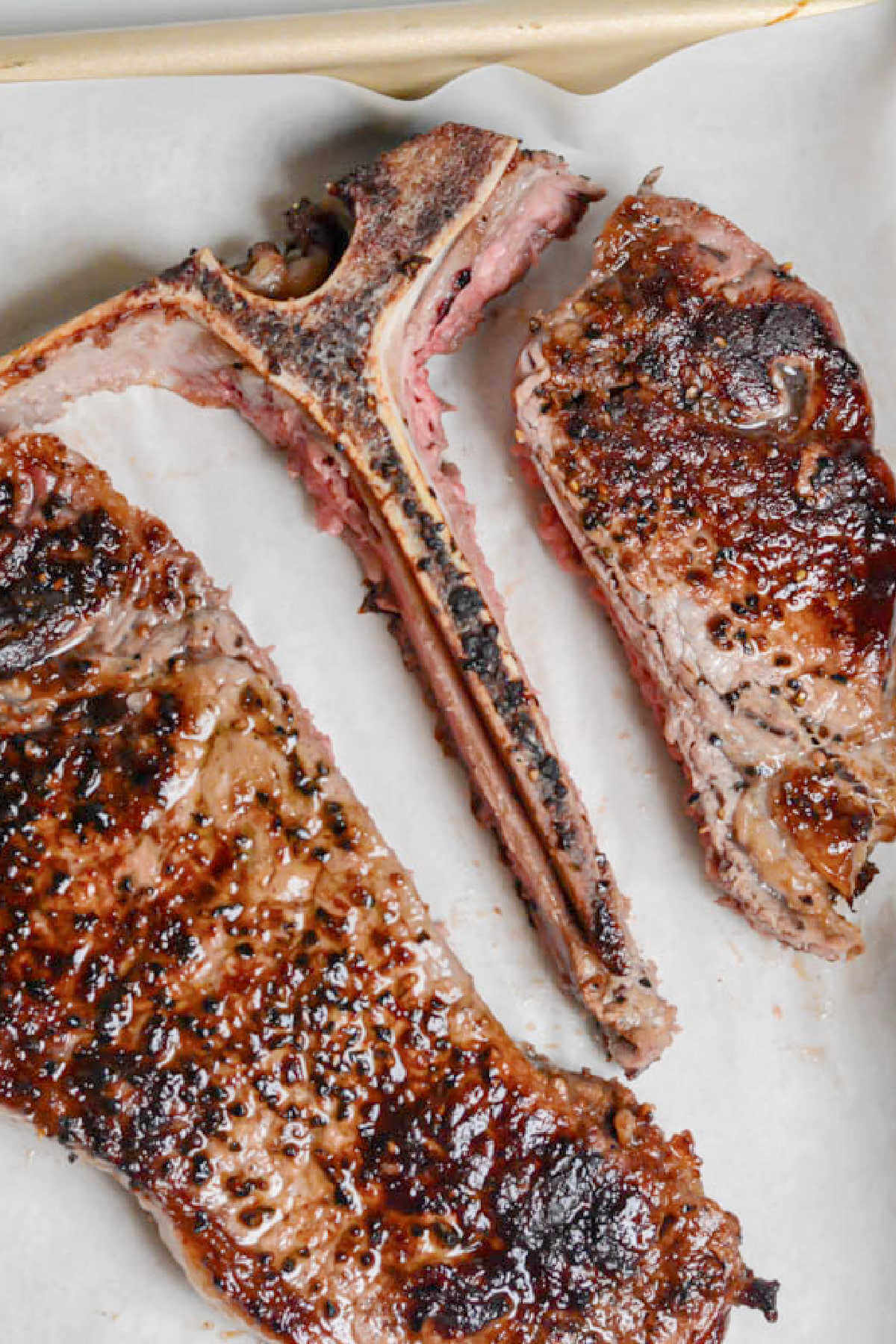
🥩What Is a Porterhouse Steak?
Porterhouse steaks are famous for their large size, which can weigh up to two pounds. It’s cut from the point where the tenderloin muscle is the biggest. On the other side of the bone is a portion of New York strip steak.
The picture-worthy look makes it a usual choice for steakhouses that showcase their best dishes.
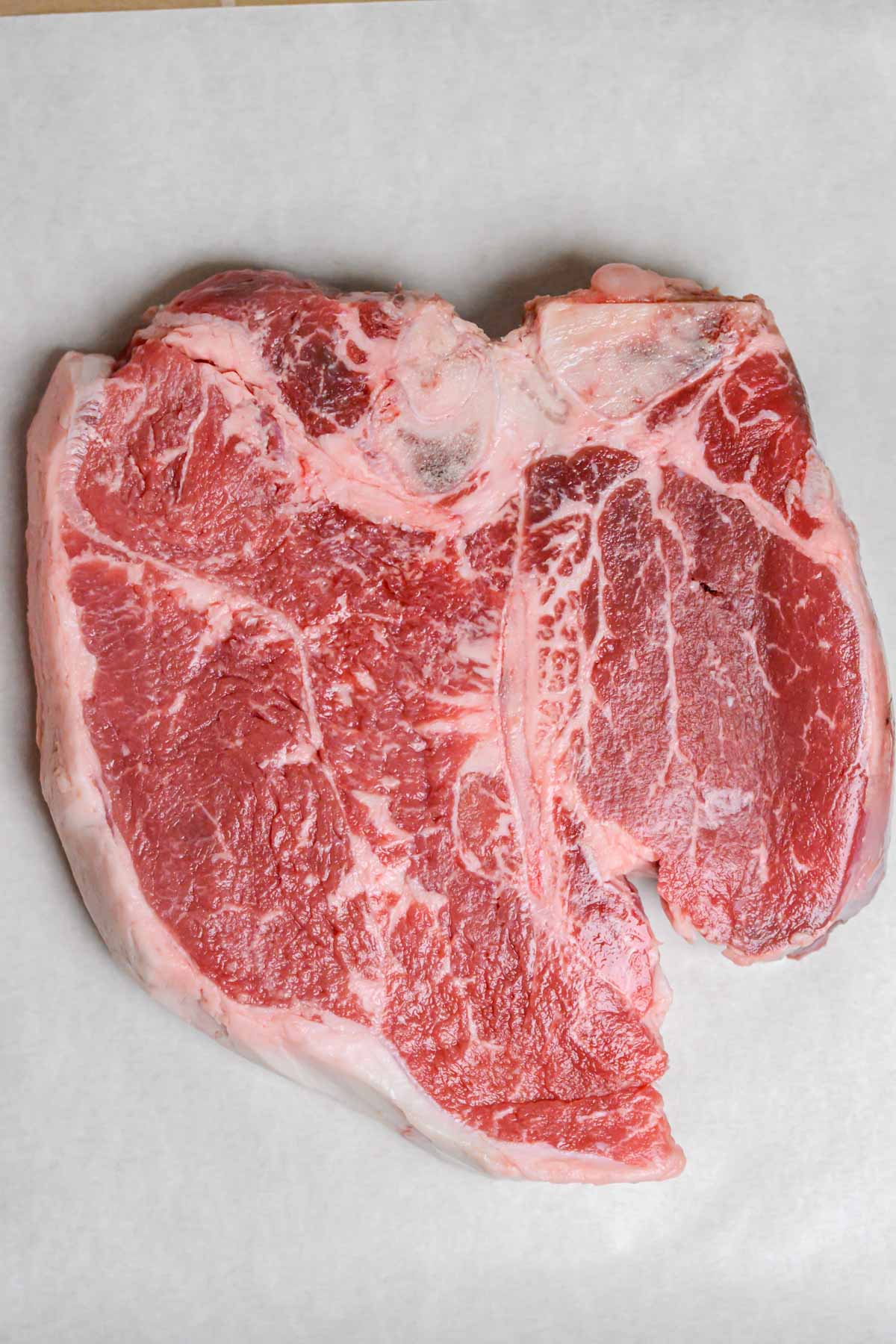
The Porterhouse steak is quite thick and high in nutrients, so you get a fulfilling portion that you can share with others. On top of that, one pound of Porterhouse steak contains a thousand calories.
Just keep in mind that because of their thickness, Porterhouse cuts generally take longer to cook. What’s more, unless their quality is compromised in any way, they tend to be more expensive.
Tip: Love the filet side of the Porterhouse? You could go for a filet mignon or tenderloin instead!
🍖What Is a T-Bone Steak?
T-bone steaks come from a similar cut as Porterhouse steaks, also from the short loin section of the cow.
However, they contain a smaller tenderloin section than the Porterhouse cut, which makes the T-bone steak leaner. Just like the Porterhouse, a section of New York strip steak is on the other side of the bone.
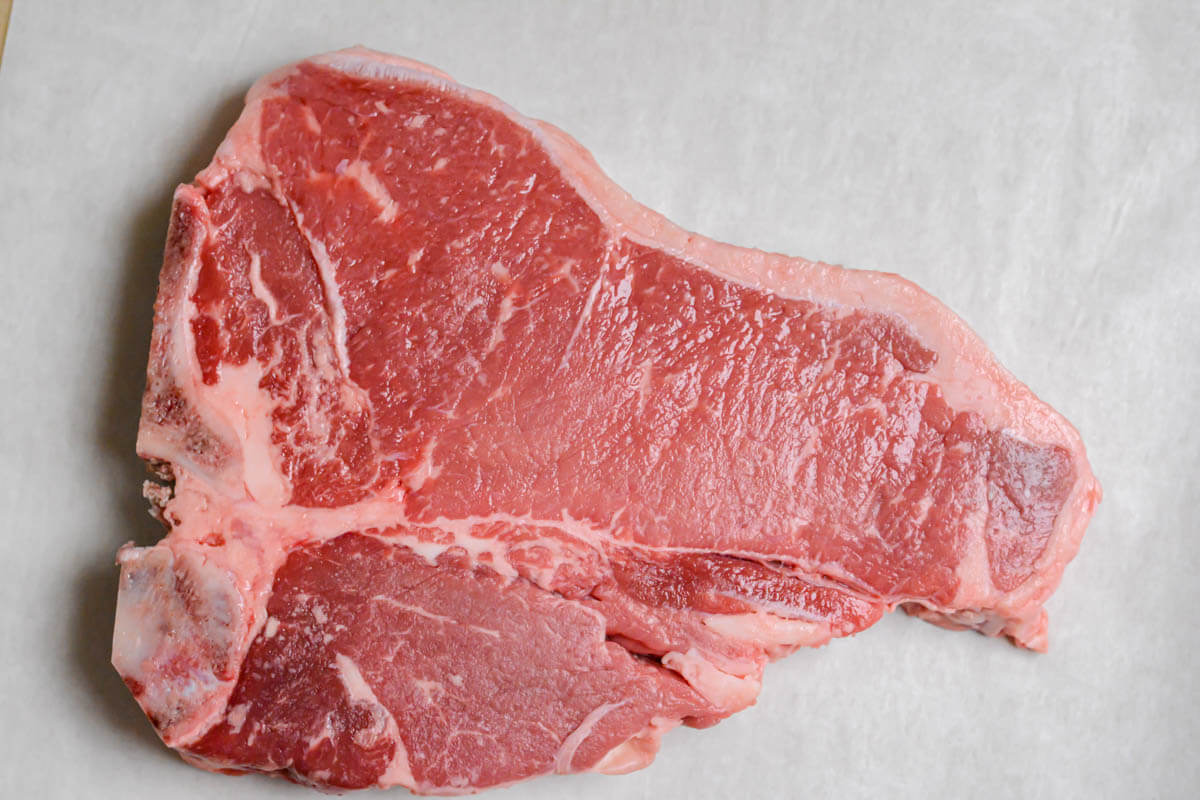
Because T-bone steaks come from an area where the muscles aren’t as active, they have a decent marbling to ensure a softer texture. This marbling makes the steak succulent when grilled.
🆚Differences
Porterhouse and T-bone steaks may appear identical to the untrained eye and it’s hard to tell the prime vs choice options. No one can deny that they have a similar appearance.
| Attribute | Porterhouse Steak | T-Bone Steak |
|---|---|---|
| Source of Cut | From the rear of the short loin, containing a thicker layer of tenderloin. | From the middle of the loin saddle, including sirloin and a smaller portion of tenderloin. |
| Appearance | Filet at least 1.25 inches wide; heavier and thicker, often served as two-person meals. | Filet between 0.5-1.25 inches wide; smaller and leaner, with a larger and fattier sirloin side. |
| Nutritional Value | Higher in fat and calories. | Leaner, with lower cholesterol and higher iron content. |
| Cooking Methods | Best grilled or pan-seared with an oven finish; requires longer cooking time due to thickness. | Best for fast grilling or reverse searing; balanced fat content suitable for bold seasonings. |
| Price | Generally more expensive, varies based on cut quality and weight. | More affordable on a price-per-pound basis, but quality and price can vary. |
| Availability | Found in high-end markets, butcher shops, and specialty stores. | Available in common supermarkets and grocery stores in various grades. |
Still, there are significant differences in size, nutritional value, preparation method, price, and even a subtle variation in shape between the two steaks.
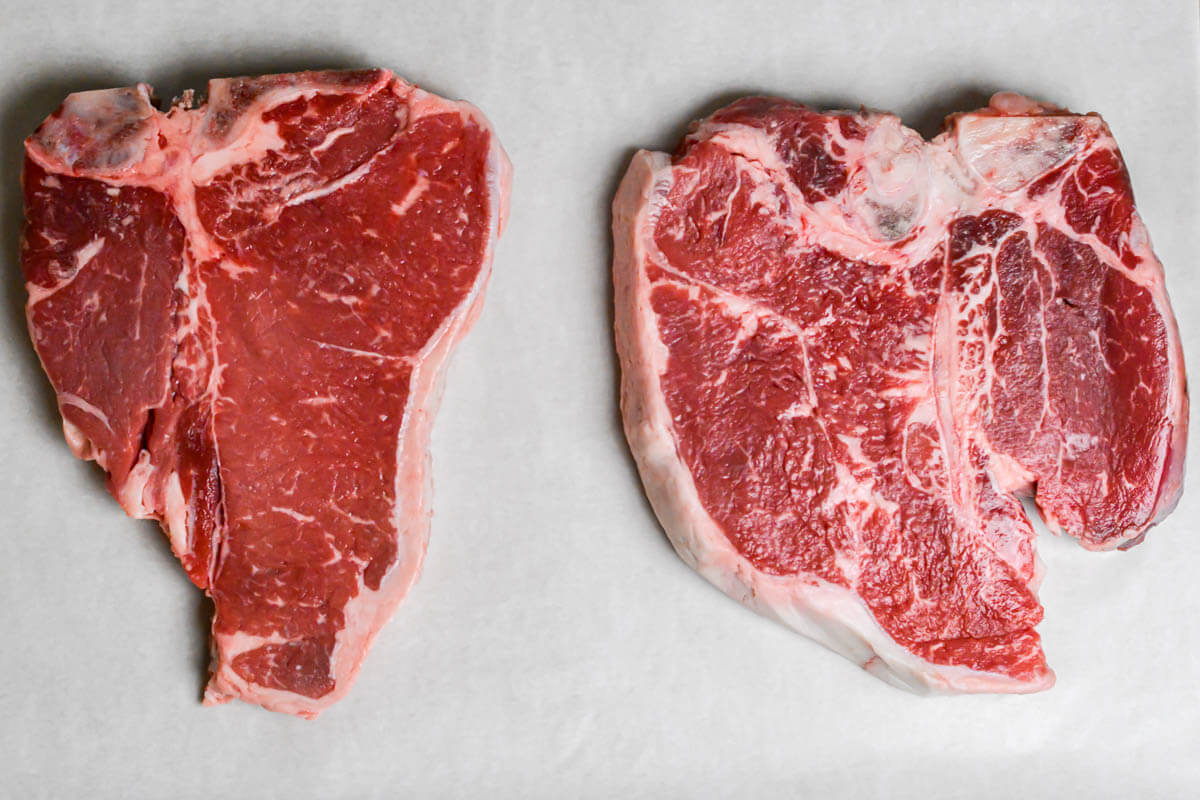
🐄Source of Cut
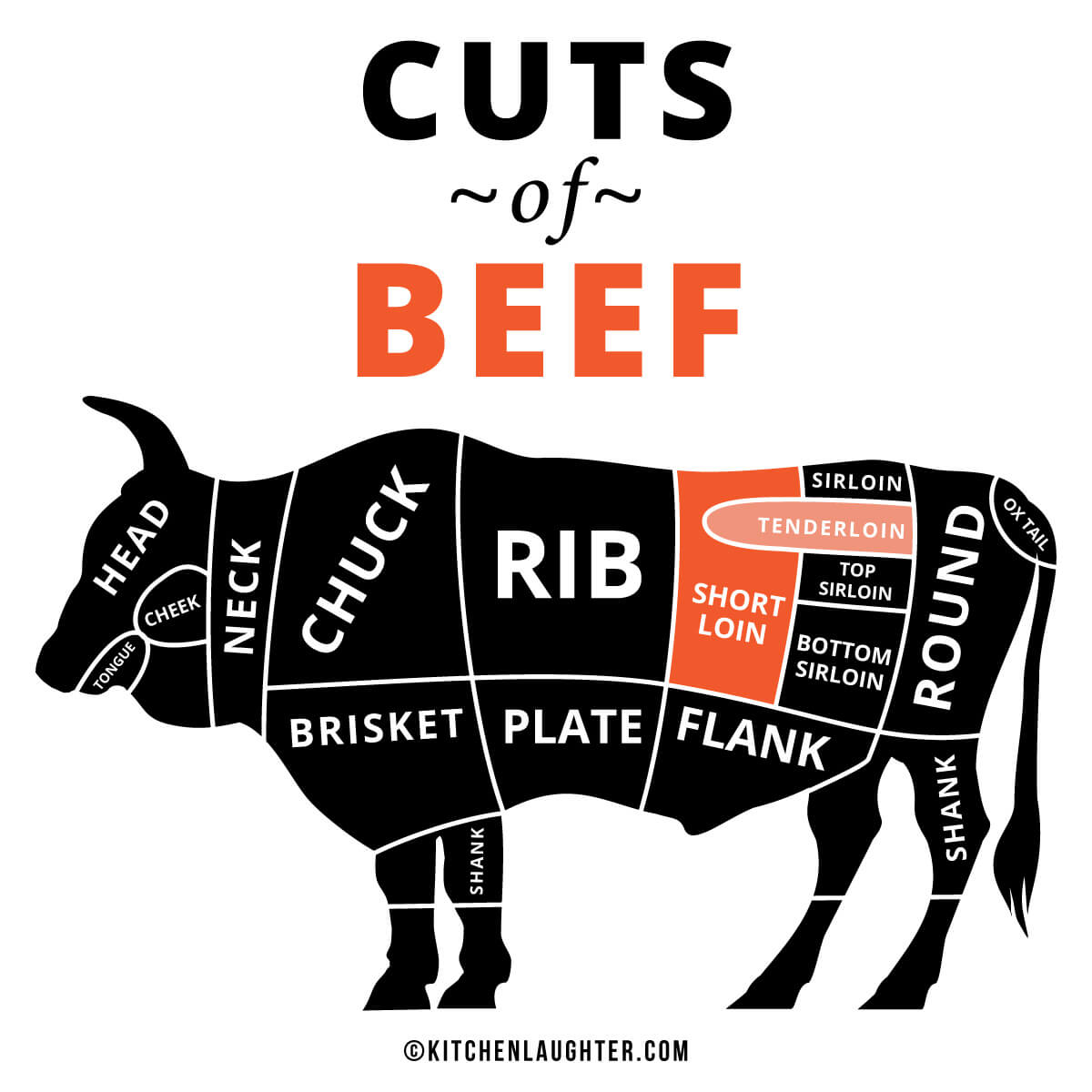
The main and most conspicuous difference you can see when comparing T-bone vs Porterhouse is the filet size and its source from the cow.
Porterhouse steaks come from two different cuts of beef: tenderloin on one side and strip steak on the other. They’re a composite steak that contains the thickest layer of tenderloin, which is the short loin located at the back of the cow.
This combo is what gives Porterhouses their bigger and thicker size. It’s almost like having an extra filet, which is why it’s often offered as a meal for two in most restaurants.
T-bone steaks are cut from the middle of the loin saddle and have sirloin as well as a small chunk of the tenderloin on both sides of the T-shaped bone. They’re smaller than Porterhouse cut, but the sirloin side tends to be larger and fattier.
⭐Conclusion | Porterhouse steaks have more filet compared to T-bone steaks, making it easy and enjoyable to share with other people. They can also serve as an indulgent meal for individuals with hearty appetites.
🔎Appearance
According to the USDA’s Institutional Meat Purchase Specification, when comparing T-Bone vs Porterhouse, the key distinguishing factor is the thickness of the filet.
The thickness is typically measured from the bone to the filet’s widest point.
For a cut to classify as a Porterhouse steak, the tenderloin portion is required to be at least 1.25 inches wide (measured from the bone to the widest point of the filet).
Porterhouse steaks can be quite weighty because they come from the short loin’s rear, which is where the filet is thickest. Indeed, many Porterhouse steaks weigh around 24 ounces, which is why they’re frequently served as two-person meals.
A filet must be 0.5-1.25 inches wide to be labeled as a T-bone steak. The reason T-bone steaks have less filet is that they’re sourced from the saddle, which contains less tenderloin.
Many specialists stress that a T-bone steak must be at least 0.25 inches thick to be classified and sold as such. Otherwise, the thin piece of meat is often sold as a bone-in NY Strip or a Club steak.
Porterhouse steaks contain more filet, which makes them heavier and thicker. As a result, they’re ideal for two-person meals or those who enjoy a large serving of steak.
⭐Conclusion | The main distinction between the T-bone and Porterhouse steaks lies in the size of the filet. Porterhouse’s filet is at least 1.25 inches while the T-bone’s tenderloin part is between 0.5-1.25 inches. The Porterhouse steak is perfect for hearty meals, while the T-bone’s smaller size makes it a versatile choice for various steak recipes.
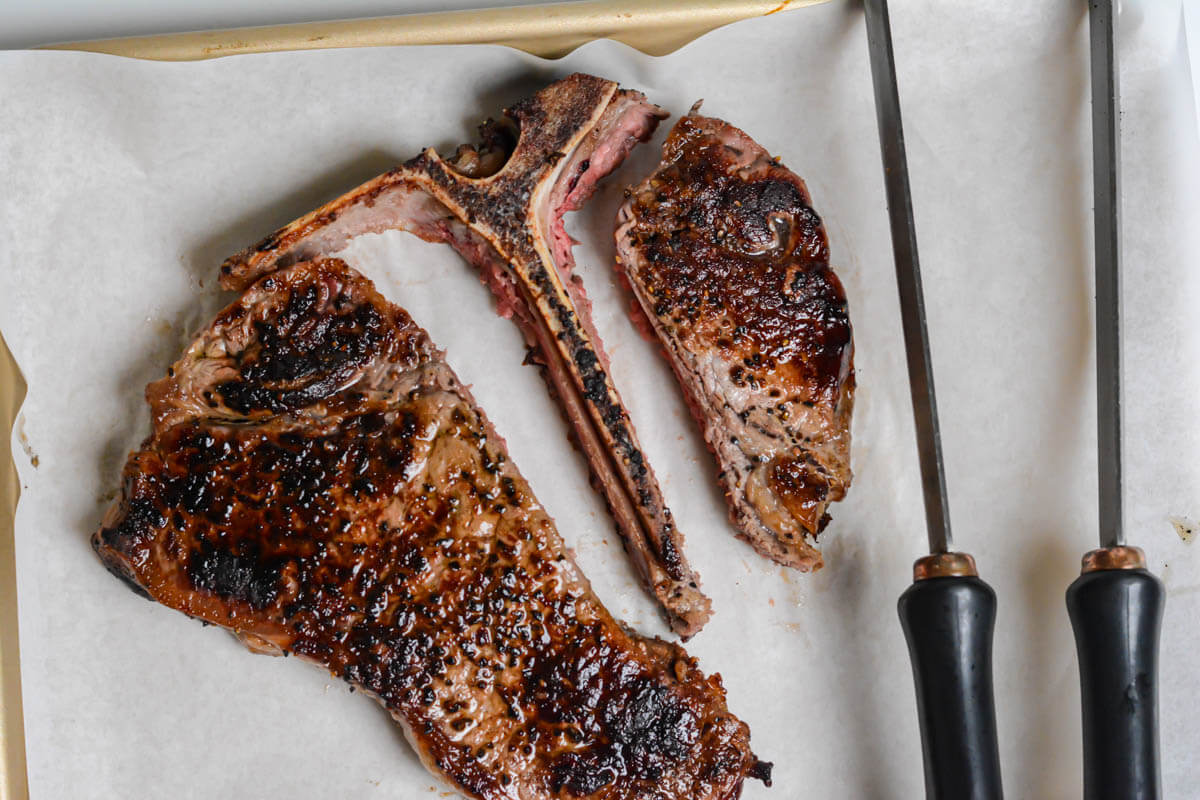
🥙Nutritional Value
| Nutrient | Porterhouse Steak (3 oz) | T-bone Steak (3 oz) |
|---|---|---|
| Calories | 283 kcal | 247 kcal |
| Protein | 23.6 g | 24.2 g |
| Total Fat | 20.2 g | 15.9 g |
| Saturated Fat | 7.43 g | 6.07 g |
| Cholesterol | 69 mg | 60 mg |
| Iron | 2.96 mg | 3.35 mg |
| Sodium | 65 mg | 67 mg |
| Vitamin B-12 | 2.19 µg | 2.19 µg |
The most significant nutritional difference between these two cuts is the fat content. The T-Bone steak is leaner than the Porterhouse, and as a result, its cholesterol content is also a bit lower.
Because T-Bone has more meat, it also delivers a higher iron content. Both are excellent sources of vitamin B12, essential for blood formation and nerve health.
⭐Conclusion | These two steaks are both nutritious choices with the Porterhouse being the slightly fattier and more caloric option.
🍳Best Cooking Methods
In the T-Bone vs Porterhouse debate, the latter cut is usually thicker and larger so it will require a longer cooking time. The fat content and distribution of the two cuts also affect how they cook on the grill.
The T-bone’s balanced fat content pairs well with bold seasonings, while the larger tenderloin filet portion of the Porterhouse is great for serving with a pat of butter or a rich sauce.
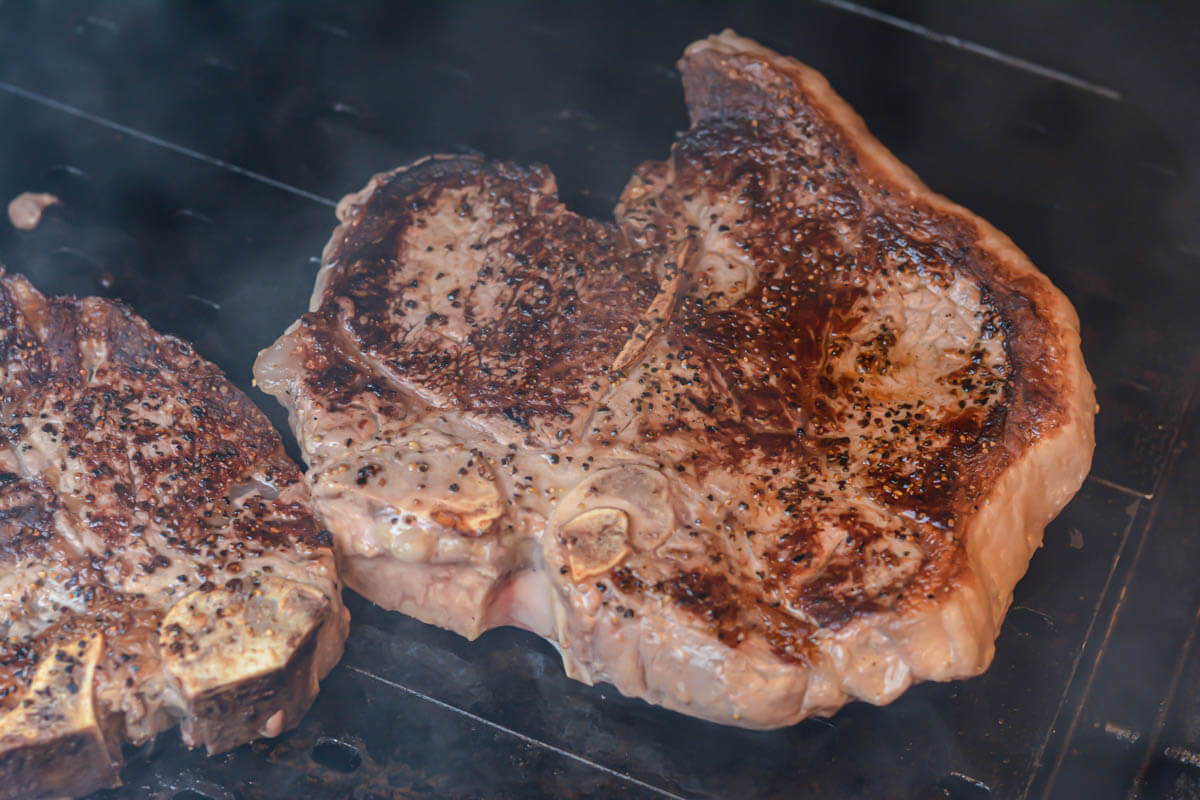
Porterhouse Steak
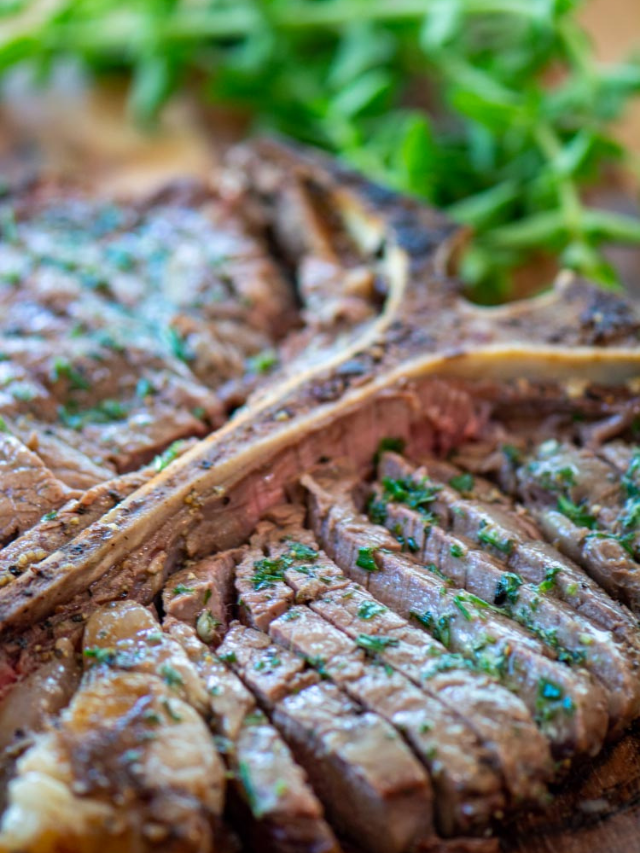
♨️Grilling | As one of the most delicious ways to enjoy a Porterhouse steak, you’ll need to grill this cut fast.
- Marinating is optional, and if you choose to do it, 30-60 minutes will be enough to infuse flavor and moisture into the meat. The Porterhouse is not a tough cut that needs a long marinating time.
- Preheat your grill to a high temperature (375-400°F). The aim is a quick sear so we need that grill hot!
- Depending on thickness, the steaks will need 6-10 minutes per side for a medium-rare to medium finish. Medium rare is 130-135°F and medium is 135-145°F.
- Remove the steak from the grill when it is 5°F under the target internal temperature. The carryover cooking will raise it to the desired doneness during the 10 minutes of resting time.
- I like to slice my grilled herb butter Porterhouse steak and brush on herb butter before serving. It adds a nice layer of richness to this flavorful meat.
🍳Pan Searing + Oven Finish | The truth is, all you need to enjoy a nice, juicy Porterhouse is a stovetop, an oven, and a cast iron skillet or another heavy bottom pan.
- Just like for grilling, you’ll want to preheat the skillet over high heat. Also preheat the oven to 375°F.
- Give it a quick sear on the stovetop, about 3-4 minutes on each side.
- Transfer it to the preheated oven.
- Cook the steak based on internal temperature, not time. A thicker cut like the Porterhouse will need 5-10 minutes in the oven.
- Remove the steak from the oven when the internal temperature is 5°F under the desired doneness.
- Let the steak rest for 10 minutes. The remaining 5 degrees will come up while the meat is resting.
T-Bone Steak
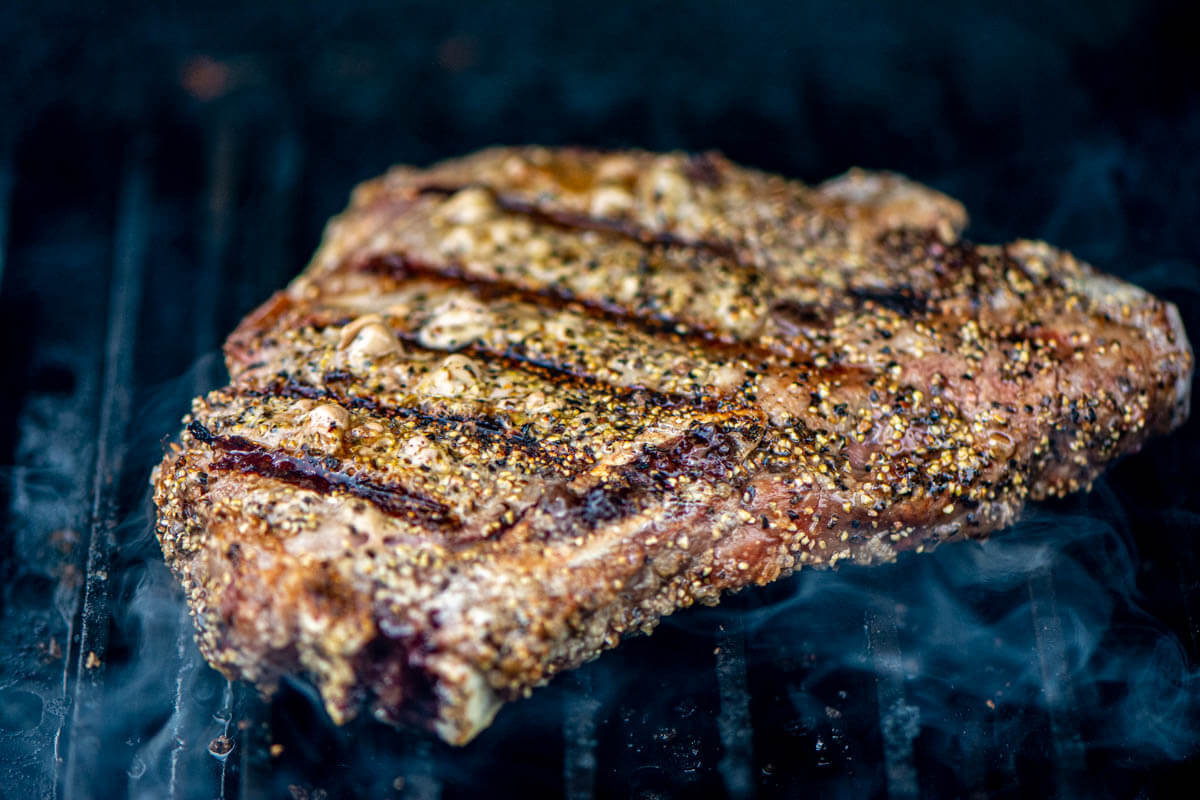
♨️Grilling | The smaller T-bone steak is a wonderful fast grilling cut. The balanced meat to fat ratio lets you season it with bolder flavored spices.
We went for a grilled Bourbon salt T-bone steak and it was fantastic!
- Take the steaks out of the fridge 30 minutes before cooking so they come up to room temperature.
- Preheat the grill to a high temperature (400°F).
- Season the steak with Bourbon salt and black pepper, or your favorite combination of herbs and spices.
- Grill for 3-4 minutes on each side for medium rare or 6-8 minutes per side for a medium finish.
- The final temperature for medium rare is 130-135°F. For medium it’s 135-145°F. Use a digital meat thermometer to monitor it and remove the T-bone steaks from the grill when they are 5°F below the targer temperature.
- Rest the steaks for 10 minutes. They will gently cook to the desired doneness during this time.
🍳Reverse Searing | A juicy cut like the T-bone is perfect for reverse searing!
- Start by cooking the steaks in a low-temperature oven (275°F) until they reach an internal temperature of about 115°F.
- Finish them on a hot grill or skillet for a few minutes per side until they are 5°F under the desired doneness.
- Rest for 10 minutes and serve.
Smoking
Before anything else, you should know smoking is not a traditional method for cooking T-Bone and Porterhouse steaks. While grilling and pan searing are more common, it’s still possible to smoke these two cuts.
The main problem is both steaks contain a tenderloin part, which should not be overcooked. Compared to the fast grilling and pan searing, smoking them is a bit trickier if you want them to turn out perfectly juicy and tender.
✔️Preparation | I prefer a simple seasoning for these steaks to let their natural, balanced beef flavor to shine. Salt and pepper, or an SPG mix (salt-pepper-garlic) are my go-to options. Nevertheless, there’s nothing wrong with using your favorite dry rub.
✔️Setup | For both cuts, preheat the smoker to a low temperature – around 225°F (107°C). Also, set up an indirect heat cooking zone.
✔️Wood Pairing | You can use our free printable smoking wood chart to find the perfect pairing for your taste.
Oak and hickory go really well with the Porterhouse infusing it with an intense smoky flavor. For the leaner T-bone, I prefer milder flavors such as apple, or cherry wood.
✔️Smoking | For the ideal medium-rare finish, smoke both the Porterhouse and T-Bone steaks to an internal temperature of 115-120°F (46-49°C).
Then, finish on a hot grill or in a sizzling cast iron pan with a quick sear until they reach 130-135°F. This is the target internal temperature for medium-rare doneness.
✔️Tips | Let the steaks sit at room temperature for 30 minutes before smoking. The meat cooks more evenly if it’s not cold when you put it in the smoker.
Monitor the temperature carefully using a digital meat thermometer. These steaks are not the most enjoyable past medium doneness. This is especially important for T-bone steaks as they are thinner than the Porterhouse. The smaller tenderloin part can easily turn dry.
Allow the steaks to rest for 10 minutes before serving so the juices have time to redistribute.
🏷️Price
The cost difference between the Porterhouse and T-bone is determined by weight, quality, how long the cut has been aged, and where you buy it from. This means that there are instances where a T-bone steak may cost more than a Porterhouse steak.
While Porterhouse steaks tend to cost more than T-bone steaks, many factors need to be taken into account to determine a cut’s price.
Porterhouse steaks are more expensive due to their thickness and weight.
Nevertheless, if a Porterhouse steak is butchered poorly, its quality goes down, which makes it cheaper. For example, a Porterhouse filet that’s thick on one side and thin on the other is uneven and thus considered of lower quality.
On a price-per-pound basis, a T-bone steak tends to cost less compared to Porterhouse filets. To check for the steak’s quality, make sure that the strip side has the larger potion.
⭐Conclusion | Because the cost varies from filet to filet, it can be difficult to put a price on either cut. Nevertheless, T-bone steaks tend to be the more affordable of the two. Also, keep in mind that both Porterhouse and T-bone steaks are still generally more expensive than other cuts of steak.
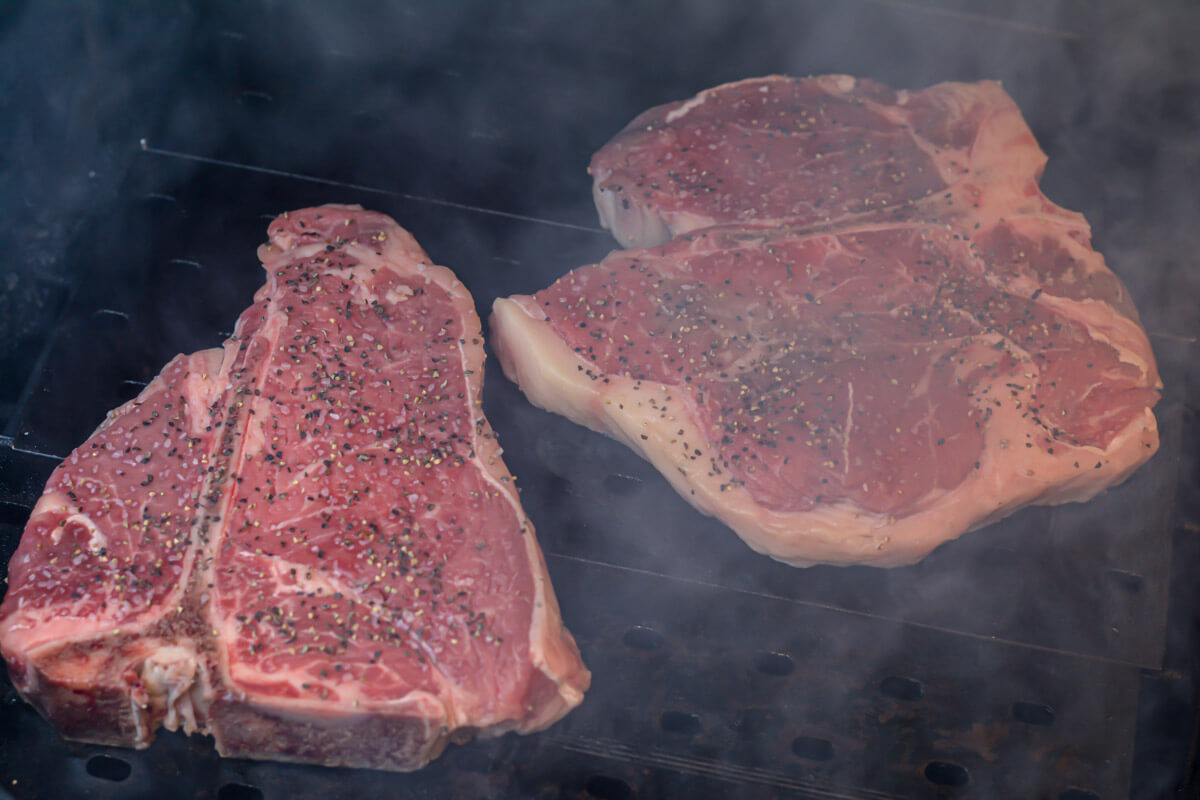
🛒Availability
You shouldn’t have any trouble finding T-bone steaks in most supermarkets, grocery stores, and butcher shops. Be careful, though. They come in various grades and you can see how choice vs prime compares before making a decision, but I recommend you don’t go lower than that.
Porterhouse steaks are considered a more premium cut, so you will find them mostly in butcher shops, high-end grocery stores, and online. Of course, higher quality T-bone steaks will also be available in these locations.
⭐Conclusion | The larger Porterhouse steaks are usually found in high-end markets, butcher shops, and specialty stores. T-bone steaks, on the other hand, are also available in common supermarkets and grocery stores in various grades.
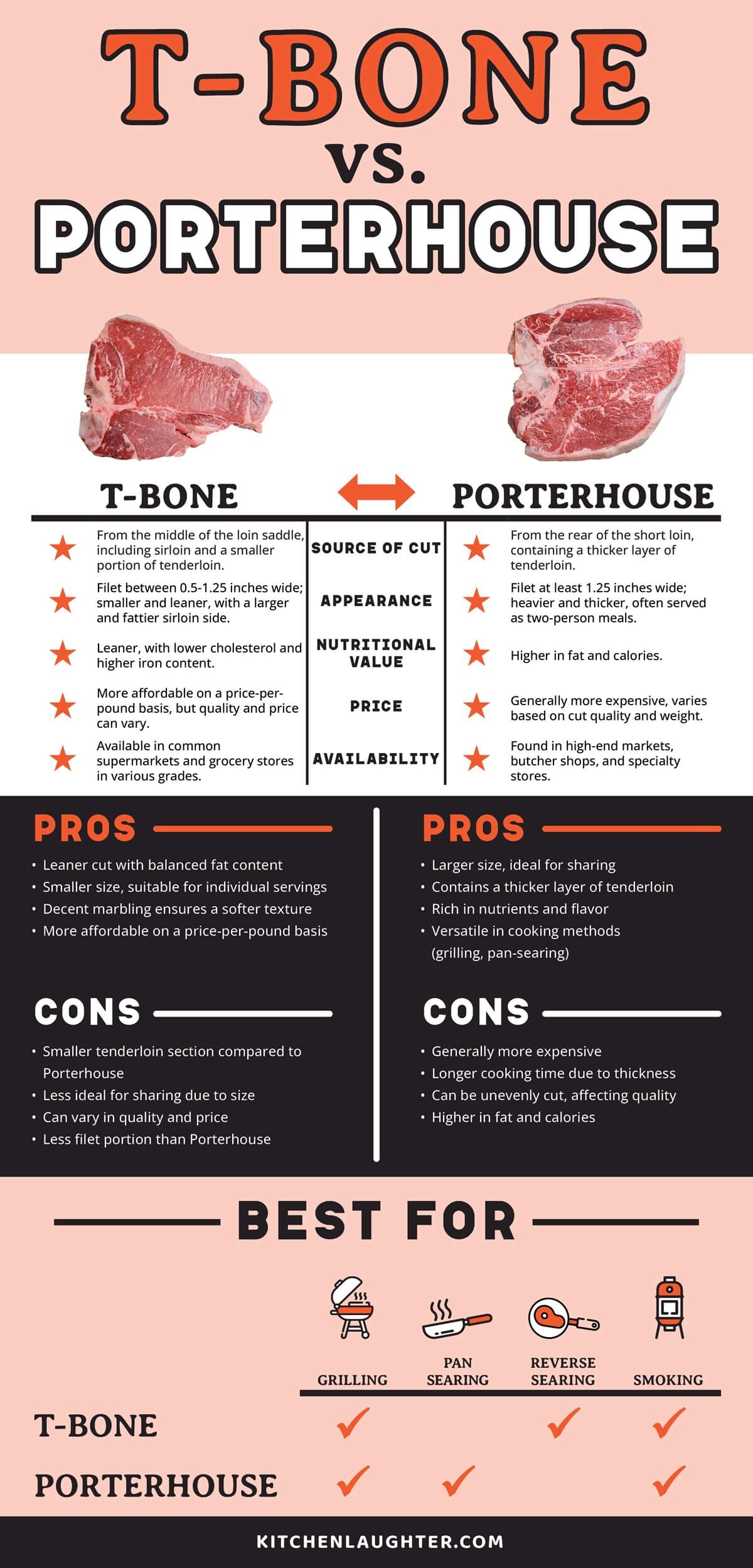
🍽️Serving Suggestions
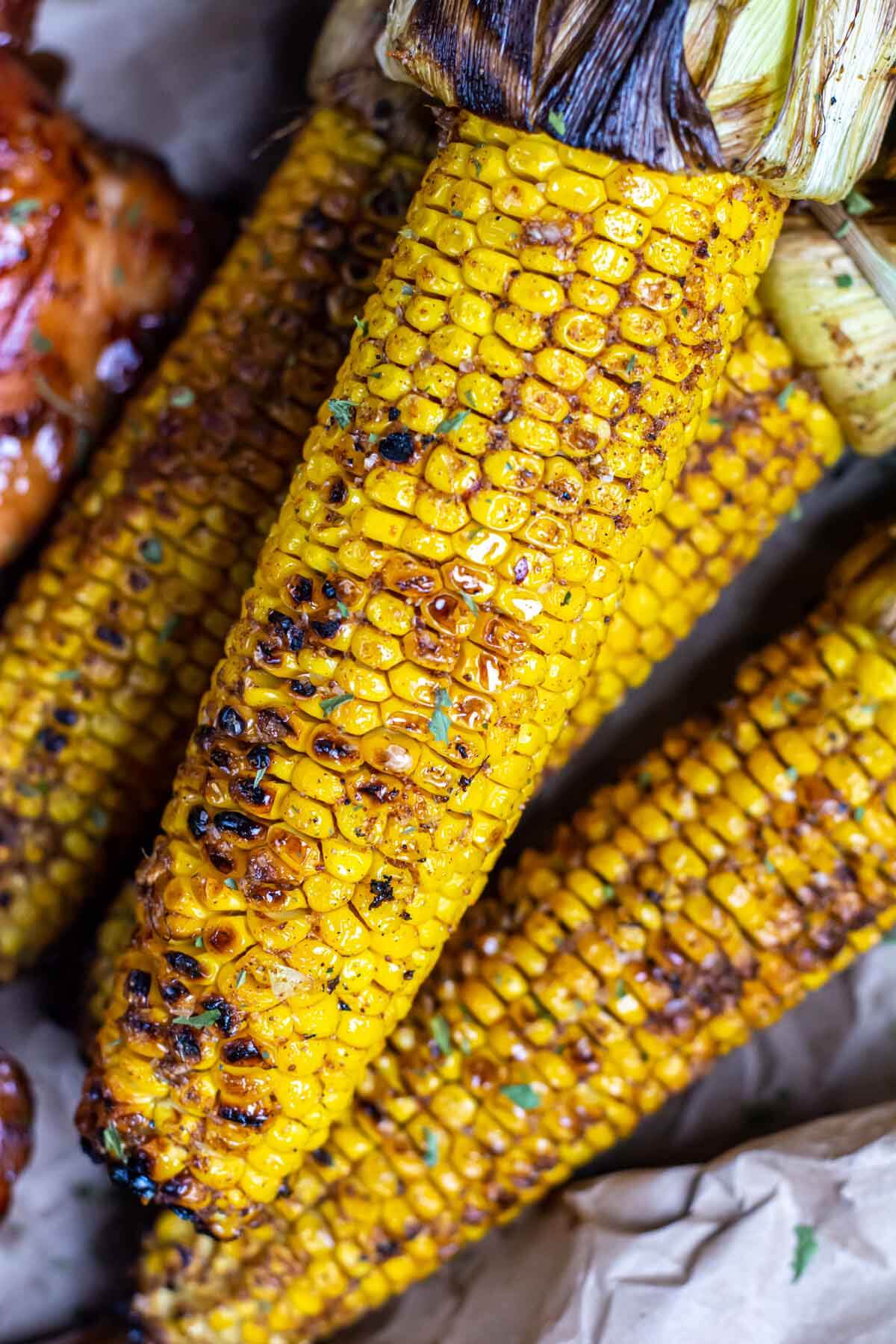
One of the reasons the T-Bone and Porterhouse steaks are such popular choices for steak lovers is their balanced flavor and tenderness.
They offer a more complex taste than a sirloin but are slightly milder than a ribeye. You’ll also get two steak experiences in one cut, so what’s not to love?
All that’s left to do is find the perfect sides to enjoy them with!
🌽Classic BBQ Sides
When in season, grilled corn on the cob in the husk is one of my go-to BBQ sides. It’s light and adds extra texture to what I call the perfect meal.
For an incredibly satisfying experience, you can’t go wrong with grilled Bourbon peach baked beans or grilled mac and cheese.
We also love these easy grilled bacon Brussels sprouts kebabs next to BBQ meat although they can certainly be a fun snack too.
It is definitely worth smoking some baby potatoes to make a smoked potato salad. This classic side can’t get any better, trust me.
There are meal-prep and make-ahead options for this amazing dish so you have more free time on the big day.
🥔Potato Sides
Grilled baked sweet potatoes provide a natural sweetness that pairs well with a hearty steak like the T-Bone or Porterhouse.
When you have a bit more time, make some smoked baked potatoes for the ultimate BBQ experience.
For a quick side, I can guarantee your guests will highly appreciate these grilled baby potatoes with garlic. Even some simple oven-roasted honey gold potatoes make a great side for steaks.
🥦Veggie Sides
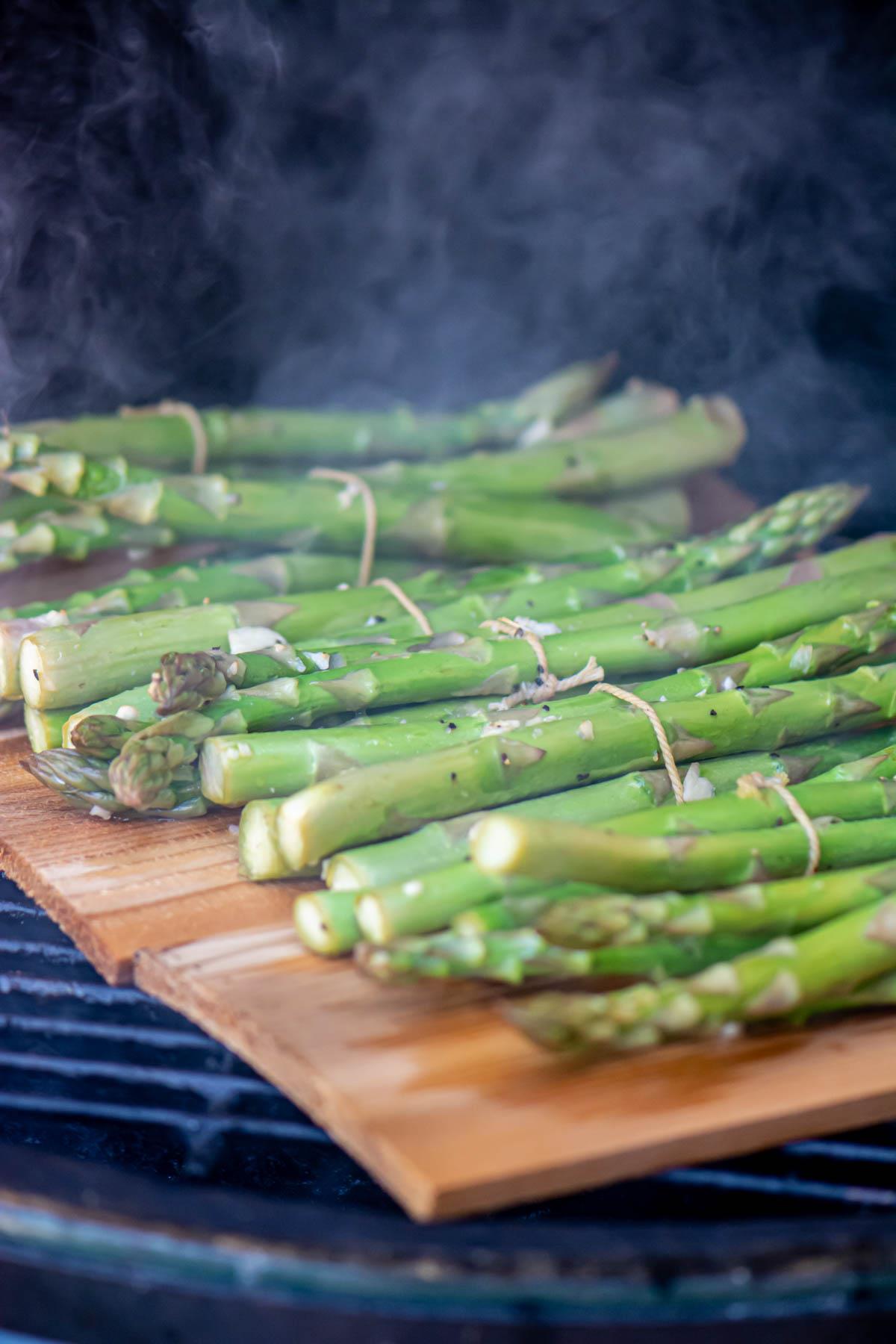
Smoked asparagus bundles with their tenderness and smoky flavor will add a gourmet touch to your steak.
I also love smoked cauliflower as an impressive-looking veggie side that does not disappoint in terms of flavor either.
If you’re looking for a lighter alternative to mashed potatoes, I swear by mashed rutabaga. The earthy, nutty flavor of this lesser-known vegetable is highly enjoyable and it’s low on carbs too.
Another fast side my family loves is grilled patty pan squash or zucchini. It’s light, easy to make, and the mild flavor goes well with any meat.
🥗Salads
Steak and a salad is an effortless pairing that tastes great and offers a well-rounded meal.
I recommend you stay away from heavier salads as a steak pairing. A simple creamy cucumber salad or a tomato cucumber and onion salad will add a refreshing layer of textures and flavors to your meal.
Of course, you can always opt for a more exotic combination like this grilled peach and arugula salad. It makes for a gorgeous presentation, perfect for special occasions.
🍚Rice & Grains
Opt for a lighter side such as cilantro lime rice, vegetarian harvest wild rice, or a fluffy quinoa salad to balance a satiating steak like the Porterhouse or T-bone.
A rice pilaf, creamy risotto, or a light couscous with grilled root vegetables are other easy sides you can enjoy next to your steak.
🍞Breads

Bread comes in many (delicious) forms and you can purchase a fresh loaf or some baguettes but you can also make your own.
With some planning, it can’t get much easier than this Dutch oven no-knead bread.
However, even if you’re a beginner when it comes to making bread, you should have no problems making soft pretzel bites, or some easy homemade breadsticks.
☯Pros & Cons
| Porterhouse Steak | T-Bone Steak | |
|---|---|---|
| Pros | Larger size, ideal for sharing Contains a thicker layer of tenderloin Rich in nutrients and flavor Versatile in cooking methods (grilling, pan-searing, smoking) | Leaner cut with balanced fat content Smaller size, suitable for individual servings Decent marbling ensures a softer texture More affordable on a price-per-pound basis |
| Cons | Generally more expensive Longer cooking time due to thickness Can be unevenly cut, affecting quality Higher in fat and calories | Smaller tenderloin section compared to Porterhouse Less ideal for sharing due to size Can vary in quality and price Less filet portion than Porterhouse |
📄The Bottom Line
Looking at T-Bone vs Porterhouse, it becomes clear the best steak is the one that suits your taste and preferences.
That said, the thicker the steak, the easier it is to cook evenly. Thicker steaks also retain moisture and tenderness better. These cooking facts evidently favor the Porterhouse steak.
What’s more, a Porterhouse steak has an abundance of nutritional value and can be shared by two or more people.
Nonetheless, if you’re looking for an equally delicious but less expensive, smaller cut, you should go for the T-bone steak.
And if an intense beefy flavor is your primary goal, take a look at our Porterhouse vs ribeye comparison. The ribeye is the richer-tasting cut you’re probably looking for.
Related Beef Recipes

Ginny Collins is a passionate foodie and recipe creator of Savor and Savvy and Kitchenlaughter. Indoors she focuses on easy, quick recipes for busy families and kitchen basics. Outdoors, she focuses on backyard grilling and smoking to bring family and friends together. She is a lifelong learner who is always taking cooking classes on her travels overseas and stateside. Her work has been featured on MSN, Parade, Fox News, Yahoo, Cosmopolitan, Elle, and many local news outlets. She lives in Florida where you will find her outside on the water in her kayak, riding her bike on trails, and planning her next overseas adventure.
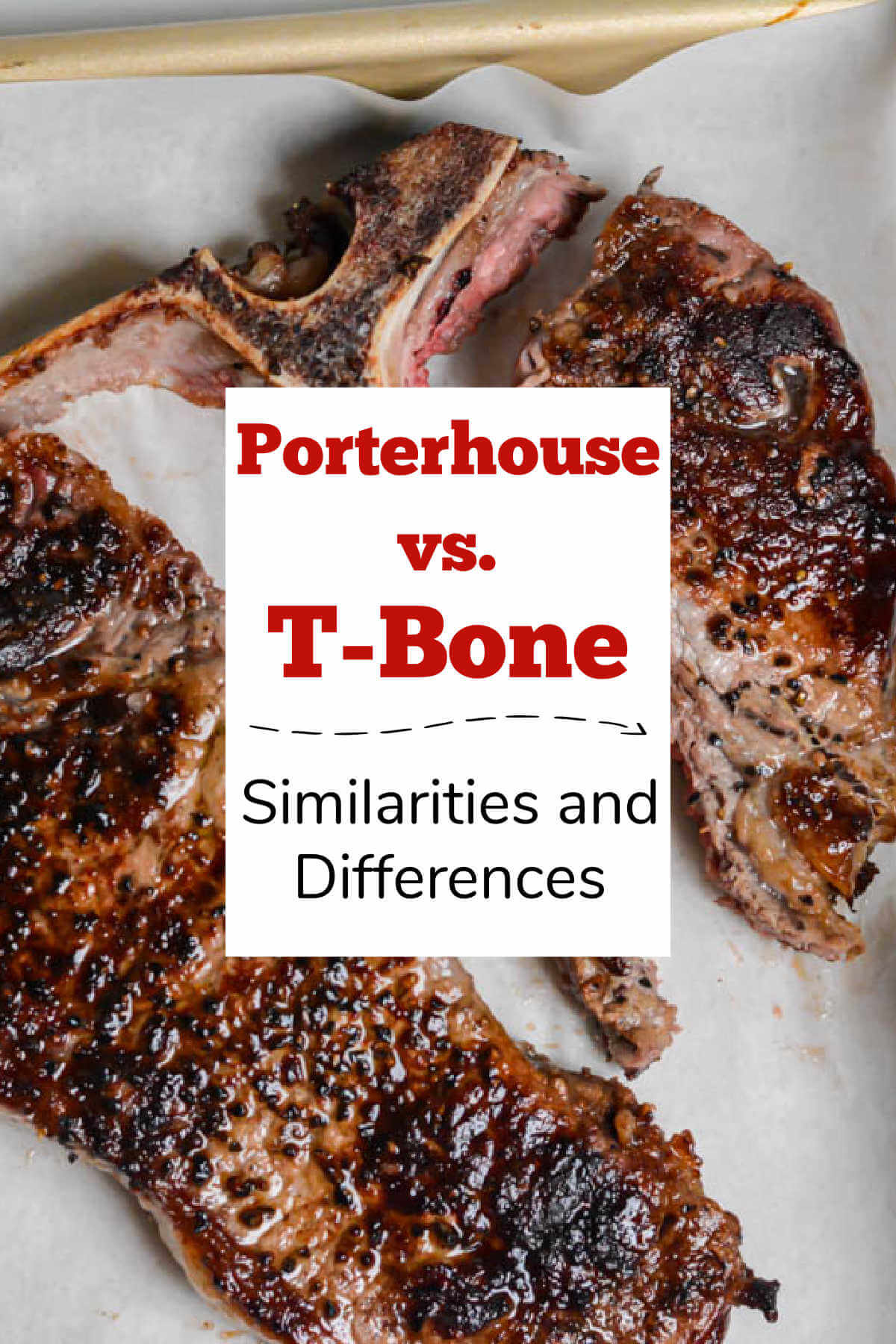

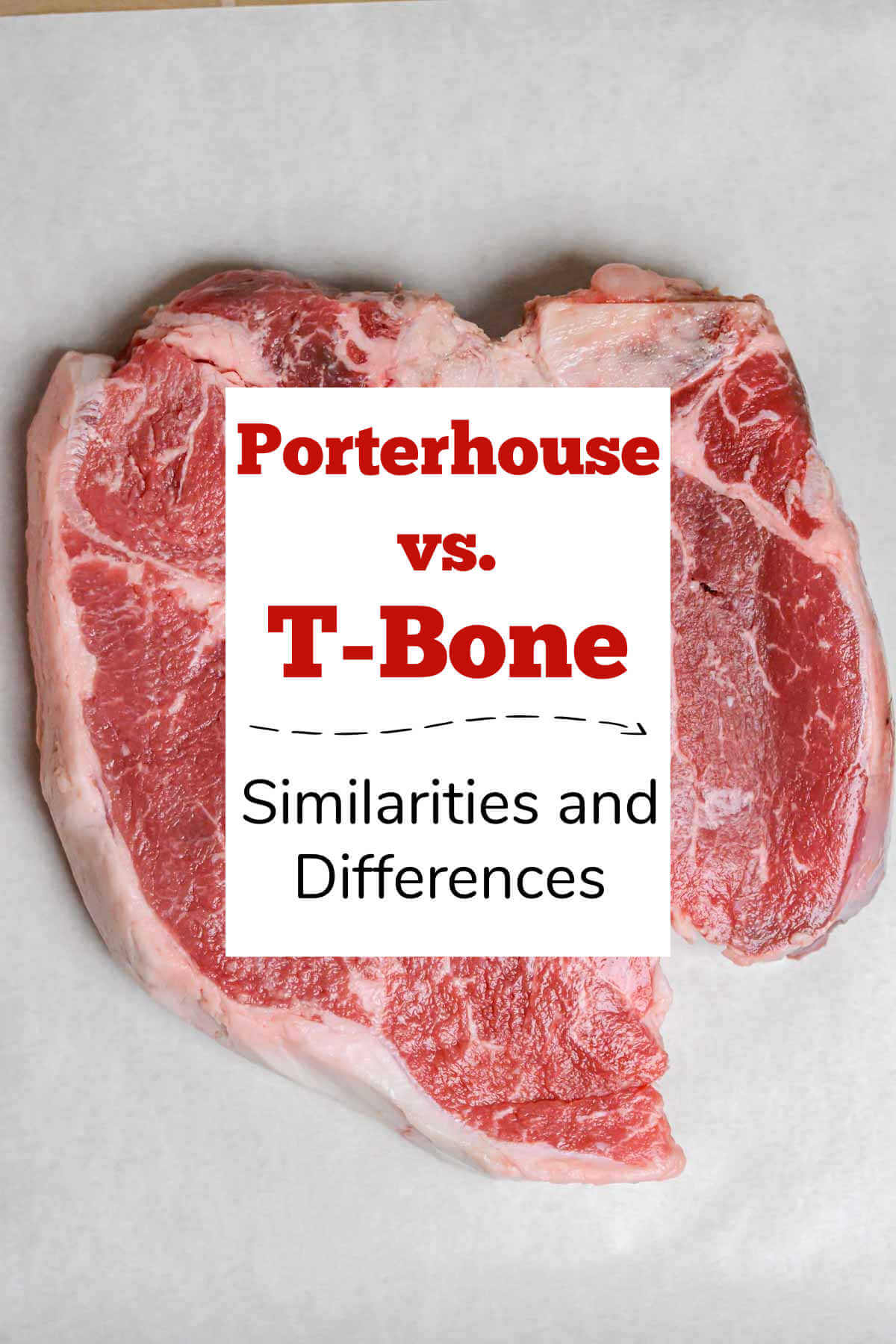




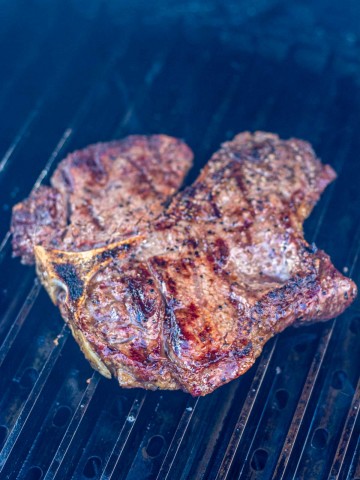
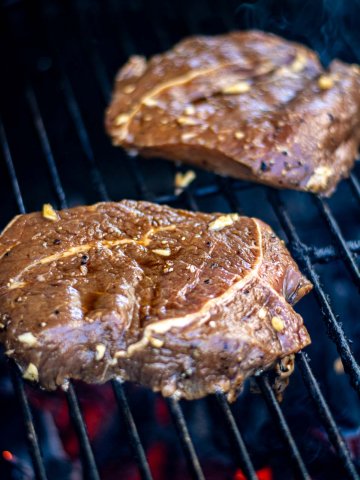
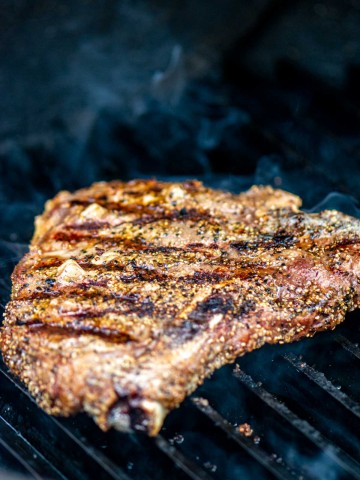
Leave a Reply